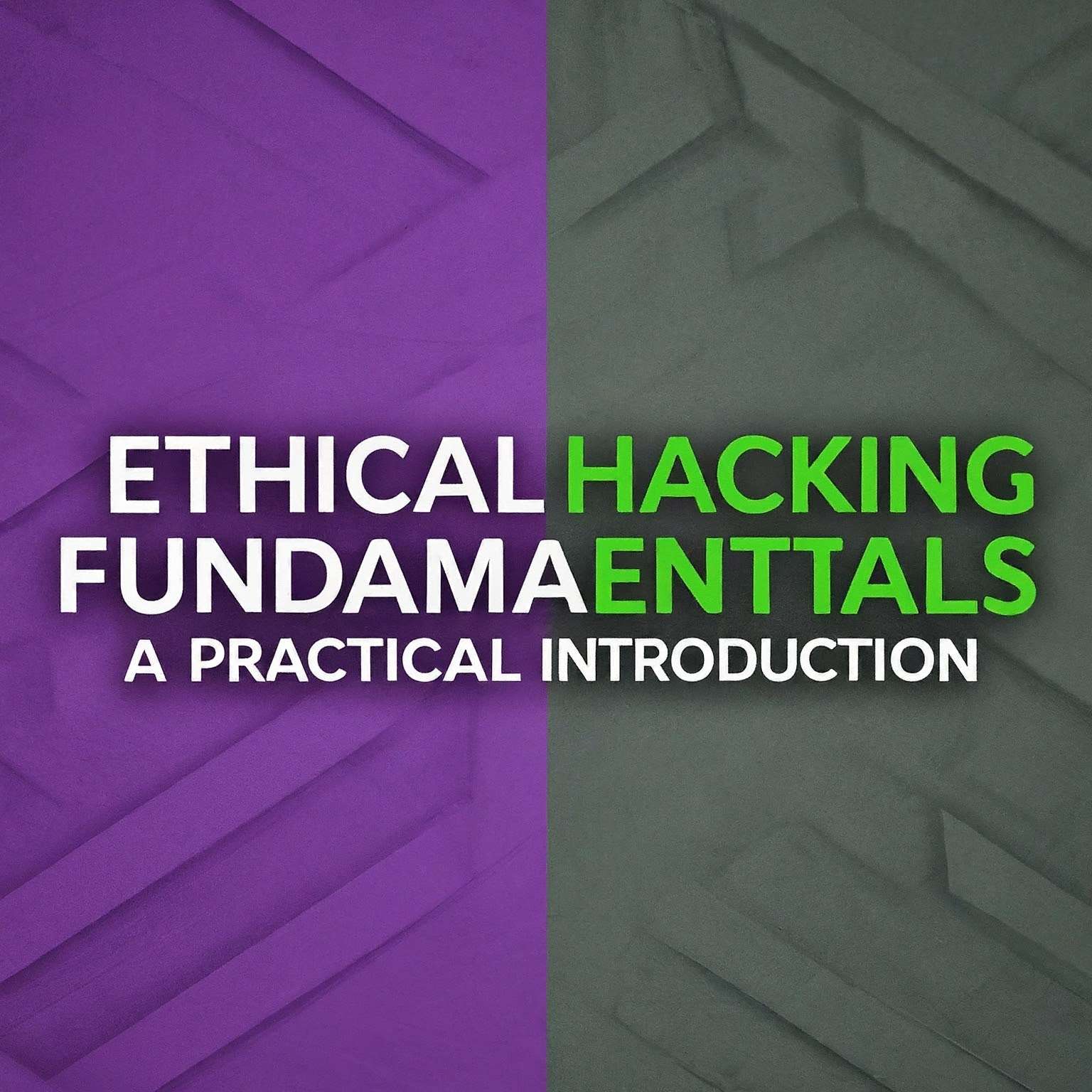Ethical Hacking Fundamentals: A Practical Introduction

About Course
Welcome to this course on Ethical Hacking Fundamentals: A Practical Introduction. To enjoy this course, you need nothing but a positive attitude and a desire to learn. No prior hacking knowledge is required.
In this course, you will learn the practical side of ethical hacking. Too many courses teach students tools and concepts that are never used in the real world. In this course, we will focus only on tools and topics that will make you successful as an ethical hacker. The course is incredibly hands on and will cover many foundational topics.
At the end of this course, you will have a deep understanding of external and internal network penetration testing, wireless penetration testing, and web application penetration testing. All lessons taught are from a real-world experience and what has been encountered on actual engagements in the field.
Note: This course has been created for educational purposes only. All attacks shown were done so with given permission. Please do not attack a host unless you have permission to do so.
What Will You Learn?
- A Day in the Life of an Ethical Hacker. What does an ethical hacker do on a day to day basis? How much can he or she make? What type of assessments might an ethical hacker perform? These questions and more will be answered.
- Effective Notekeeping. An ethical hacker is only as good as the notes he or she keeps. We will discuss the important tools you can use to keep notes and be successful in the course and in the field.
- Networking Refresher. This section focuses on the concepts of computer networking. We will discuss common ports and protocols, the OSI model, subnetting, and even walk through a network build with using Cisco CLI.
- Introductory Linux. Every good ethical hacker knows their way around Linux. This section will introduce you to the basics of Linux and ramp up into building out Bash scripts to automate tasks as the course develops.
- Introductory Python. Most ethical hackers are proficient in a programming language. This section will introduce you to one of the most commonly used languages among ethical hackers, Python. You'll learn the ins and outs of Python 3 and by the end, you'll be building your own port scanner and writing exploits in Python.
- Hacking Methodology. This section overviews the five stages of hacking, which we will dive deeper into as the course progresses.
- Reconnaissance and Information Gathering. You'll learn how to dig up information on a client using open source intelligence. Better yet, you'll learn how to extract breached credentials from databases to perform credential stuffing attacks, hunt down subdomains during client engagements, and gather information with Burp Suite.
- Scanning and Enumeration. One of the most important topics in ethical hacking is the art of enumeration. You'll learn how to hunt down open ports, research for potential vulnerabilities, and learn an assortment of tools needed to perform quality enumeration.
- Exploitation Basics. Here, you'll exploit your first machine! We'll learn how to use Metasploit to gain access to machines, how to perform manual exploitation using coding, perform brute force and password spraying attacks, and much more.
- Mid-Course Capstone. This section takes everything you have learned so far and challenges you with 10 vulnerable boxes that order in increasing difficulty. You'll learn how an attacker thinks and learn new tools and thought processes along the way. Do you have what it takes?
- Exploit Development. This section discusses the topics of buffer overflows. You will manually write your own code to exploit a vulnerable program and dive deep into registers to understand how overflows work. This section includes custom script writing with Python 3.
- Active Directory. Did you know that 95% of the Fortune 1000 companies run Active Directory in their environments? Due to this, Active Directory penetration testing is one of the most important topics you should learn and one of the least taught. The Active Directory portion of the course focuses on several topics. You will build out your own Active Directory lab and learn how to exploit it. Attacks include, but are not limited to: LLMNR poisoning, SMB relays, IPv6 DNS takeovers, pass-the-hash/pass-the-password, token impersonation, kerberoasting, GPP attacks, golden ticket attacks, and much more. You'll also learn important tools like mimikatz, Bloodhound, and PowerView. This is not a section to miss!
- Post Exploitation. The fourth and fifth stages of ethical hacking are covered here. What do we do once we have exploited a machine? How do we transfer files? How do we pivot? What are the best practices for maintaining access and cleaning up?
- Web Application Penetration Testing. In this section, we revisit the art of enumeration and are introduced to several new tools that will make the process easier. You will also learn how to automate these tools utilize Bash scripting. After the enumeration section, the course dives into the OWASP Top 10. We will discuss attacks and defenses for each of the top 10 and perform walkthroughs using vulnerable web applications. Topics include: SQL Injection, Broken Authentication, Sensitive Data Exposure, XML External Entities (XXE), Broken Access Control, Security Misconfigurations, Cross-Site Scripting (XSS), Insecure Deserialization, Using Components with Known Vulnerabilities, and Insufficient Logging and Monitoring
- Wireless Attacks. Here, you will learn how to perform wireless attacks against WPA2 and compromise a wireless network in under 5 minutes.
- Legal Documentation and Report Writing. A topic that is hardly ever covered, we will dive into the legal documents you may encounter as a penetration tester, including Statements of Work, Rules of Engagement, Non-Disclosure Agreements, and Master Service Agreements. We will also discuss report writing. You will be provided a sample report as well as walked through a report from an actual client assessment.
- Career Advice. The course wraps up with career advice and tips for finding a job in the field.
Course Content
Introduction
-
Course Introduction
00:00 -
A Day in the Life of an Ethical Hacker
00:00 -
Why You Shouldn’t Be An Ethical Hacker
00:00 -
Section Quiz
Notekeeping
-
Effective Notekeeping
00:00 -
Important Tools
00:00 -
Section Quiz
Networking Refresher
-
Introduction
00:00 -
IP Addresses
00:00 -
MAC Addresses
00:00 -
TCP, UDP, and the Three-Way Handshake
00:00 -
Common Ports and Protocols
00:00 -
The OSI Model
00:00 -
Subnetting Part 1
00:00 -
Subnetting Part 2
00:00 -
Section Quiz
Setting Up Our Lab
-
Installing VMWare / VirtualBox
00:00 -
Configuring VirtualBox
00:00 -
Installing Kali Linux
00:00 -
Section Quiz
Introduction to Linux
-
Exploring Kali Linux
00:00 -
Sudo Overview
00:00 -
Navigating the File System
00:00 -
Users and Privileges
00:00 -
Common Network Commands
00:00 -
Viewing, Creating, and Editing Files
00:00 -
Starting and Stopping Services
00:00 -
Installing and Updating Tools
00:00 -
Scripting with Bash
00:00 -
Section Quiz
Introduction to Python
-
Introduction
00:00 -
Strings
00:00 -
Math
00:00 -
Variables and Methods
00:00 -
Functions
00:00 -
Boolean Expressions and Relational Operators
00:00 -
Conditional Statements
00:00 -
Lists
00:00 -
Tuples
00:00 -
Looping
00:00 -
Advanced Strings
00:00 -
Dictionaries
00:00 -
Importing Modules
00:00 -
Sockets
00:00 -
Building a Port Scanner
00:00 -
User Input
00:00 -
Reading and Writing Files
00:00 -
Classes and Objects
00:00 -
Building a Shoe Budget Tool
00:00 -
Section Quiz
The Ethical Hacker Methodology
-
The Five Stages of Ethical Hacking
00:00 -
Section Quiz
Information Gathering (Reconnaissance)
-
Passive Reconnaissance Overview
00:00 -
Identifying Our Target
00:00 -
Discovering Email Addresses
00:00 -
Gathering Breached Credentials with Breach-Parse
00:00 -
Hunting Breached Credentials with DeHashed
00:00 -
Hunting Subdomains Part 1
00:00 -
Hunting Subdomains Part 2
00:00 -
Identifying Website Technologies
00:00 -
Information Gathering with Burp Suite
00:00 -
Google Fu
00:00 -
Utilizing Social Media
00:00 -
Additional Learning (OSINT Fundamentals)
00:00 -
Section Quiz
Scanning & Enumeration
-
Installing Kioptrix
00:00 -
Scanning with Nmap
00:00 -
Enumerating HTTP and HTTPS Part 1
00:00 -
Enumerating HTTP and HTTPS Part 2
00:00 -
Enumerating SMB
00:00 -
Enumerating SSH
00:00 -
Researching Potential Vulnerabilities
00:00 -
Our Notes So Far
00:00 -
Section Quiz
Vulnerability Scanning with Nessus
-
Scanning with Nessus Part 1
00:00 -
Scanning with Nessus Part 2
00:00 -
Section Quiz
Exploitation Basics
-
Reverse Shells vs Bind Shells
00:00 -
Staged vs Non-Staged Payloads
00:00 -
Gaining Root with Metasploit
00:00 -
Manual Exploitation
00:00 -
Brute Force Attacks
00:00 -
Credential Stuffing and Password Spraying
00:00 -
Our Notes, Revisited
00:00 -
Section Quiz
New Capstone
-
Introduction
00:00 -
Set Up – Blue
00:00 -
Walkthrough – Blue
00:00 -
Set Up – Academy
00:00 -
Walkthrough – Academy
00:00 -
Walkthrough – Dev
00:00 -
Walkthrough – Butler
00:00 -
Walkthrough – Blackpearl
00:00
Introduction to Exploit Development (Buffer Overflows)
-
Required Installations
00:00 -
Buffer Overflows Explained
00:00 -
Spiking
00:00 -
Fuzzing
00:00 -
Finding the Offset
00:00 -
Overwriting the EIP
00:00 -
Finding Bad Characters
00:00 -
Finding the Right Module
00:00 -
Generating Shellcode and Gaining Root
00:00 -
Exploit Development Using Python3 and Mona
00:00 -
Section Quiz
Active Directory Overview
-
Active Directory Overview
00:00 -
Physical Active Directory Components
00:00 -
Logical Active Directory Components
00:00 -
Section Quiz
Active Directory Lab Build
-
Lab Overview and Requirements
00:00 -
Downloading Necessary ISOs
00:00 -
Setting Up the Domain Controllers
00:00 -
Setting Up the User Machines
00:00 -
Setting Up Users, Groups, and Policies
00:00 -
Joining Our Machines to the Domain
00:00 -
Lab Build – (Cloud Alternative)
00:00
Attacking Active Directory: Initial Attack Vectors
-
Introduction
00:00 -
LLMNR Poisoning Overview
00:00 -
Capturing NTLMv2 Hashes with Responder
00:00 -
Password Cracking with Hashcat
00:00 -
LLMNR Poisoning Defense
00:00 -
SMB Relay Attacks Overview
00:00 -
Quick Lab Update
00:00 -
Discovering Hosts with SMB Signing Disabled
00:00 -
SMB Relay Attack Demonstration Part 1
00:00 -
SMB Relay Attack Demonstration Part 2
00:00 -
SMB Relay Attack Defenses
00:00 -
Gaining Shell Access
00:00 -
IPv6 Attacks Overview
00:00 -
Installing mitm6
00:00 -
Setting Up LDAPS
00:00 -
IPv6 DNS Takeover via mitm6
00:00 -
IPv6 Attack Defenses
00:00 -
Passback Attacks
00:00 -
Other Attack Vectors and Strategies
00:00
Attacking Active Directory: Post-Compromise Enumeration
-
Introduction
00:00 -
PowerView Overview
00:00 -
Domain Enumeration with PowerView
00:00 -
Bloodhound Overview and Setup
00:00 -
Grabbing Data with Invoke-Bloodhound
00:00 -
Enumerating Domain Data with Bloodhound
00:00
Attacking Active Directory: Post-Compromise Attacks
-
Introduction
00:00 -
Pass the Hash / Password Overview
00:00 -
Installing crackmapexec
00:00 -
Pass the Password Attacks
00:00 -
Dumping Hashes with secretsdump.py
00:00 -
Cracking NTLM Hashes with Hashcat
00:00 -
Pass the Hash Attacks
00:00 -
Pass Attack Mitigations
00:00 -
Token Impersonation Overview
00:00 -
Token Impersonation with Incognito
00:00 -
Token Impersonation Mitigation
00:00 -
Kerberoasting Overview
00:00 -
Kerberoasting Walkthrough
00:00 -
Kerberoasting Mitigation
00:00 -
GPP / cPassword Attacks Overview
00:00 -
Abusing GPP: Part 1
00:00 -
Abusing GPP: Part 2
00:00 -
URL File Attacks
00:00 -
PrintNightmare (CVE-2021-1675) Walkthrough
00:00 -
Mimikatz Overview
00:00 -
Credential Dumping with Mimikatz
00:00 -
Golden Ticket Attacks
00:00 -
Conclusion and Additional Resources
00:00
Additional Active Directory Attacks
-
Abusing ZeroLogon
00:00
